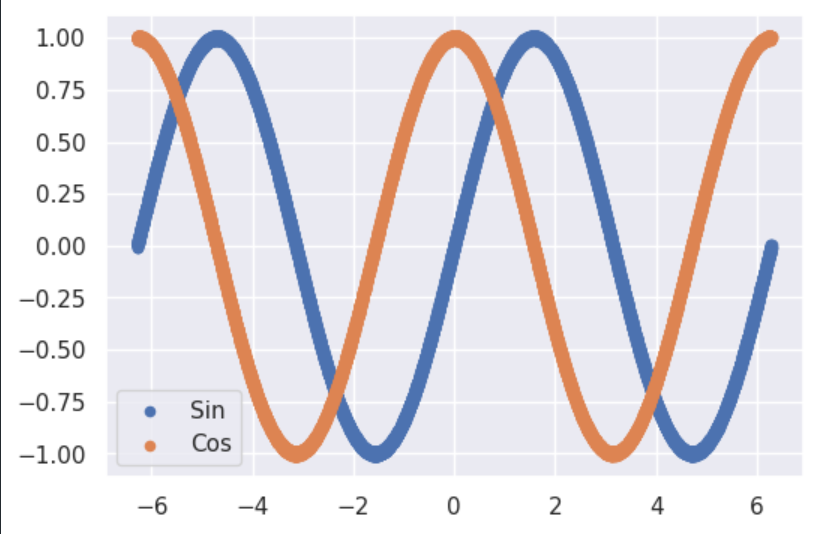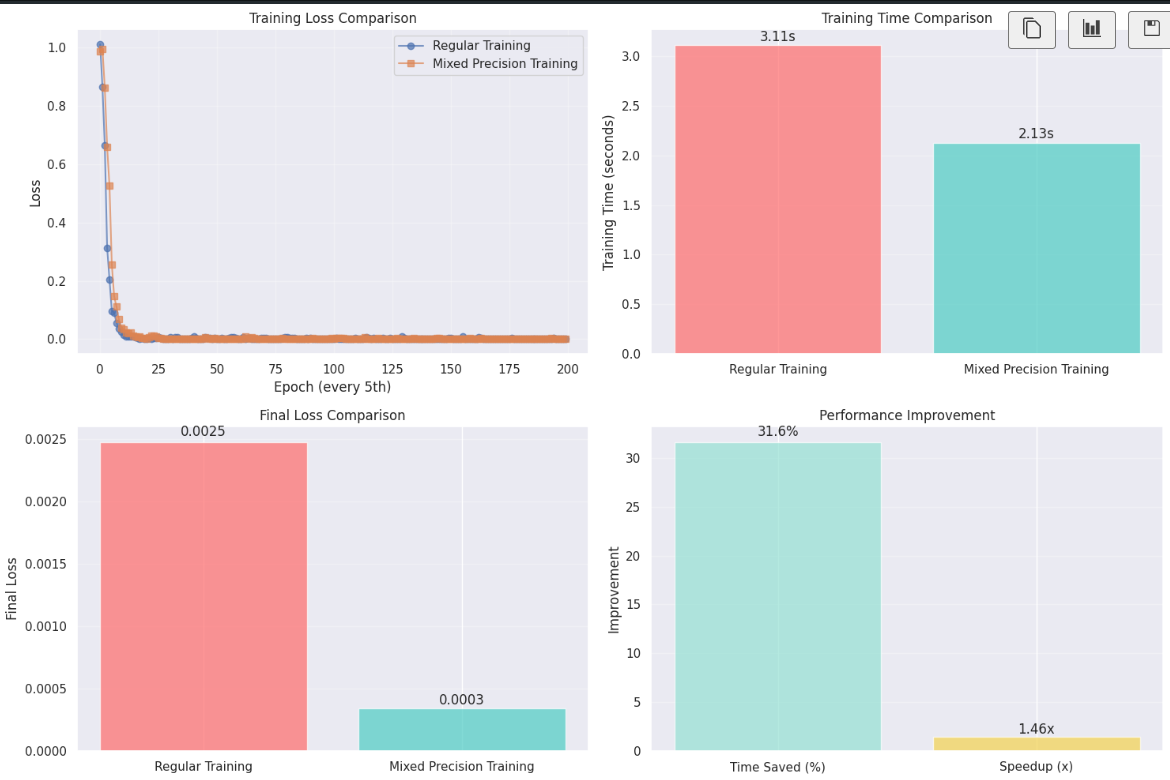运行时长和内存优化:混合精度训练(MPT)案例和梯度检查点(GCP)
1. 混合精度训练 Mixed Precision Training, MPT
混合精度训练(Mixed Precision Training) 是一种 深度学习优化技术,旨在使用 不同精度的数据类型(如 FP32 和 FP16) 进行训练,以 减少计算开销、降低显存占用,并提高模型训练速度,同时保持与全精度训练相近的模型精度。
这里就直接用一个例子来展示一下MPT的效果
先导入必要的库,其中比较关键的时最后一个GradScalar和autocast
import torch
import time
import torch.nn as nn
import numpy as np
import matplotlib.pyplot as plt
import seaborn as sns
from torch.cuda.amp import GradScaler, autocastsns.set()此书前面的章节介绍了用神经网络构造一个sin-cos多任务训练网络,我们还是以那个栗子来实践,先定义一下数据:
high = 2 * np.pi
x = torch.unsqueeze(torch.linspace(-high, high, 20000), dim=1)
x = x[torch.randperm(x.shape[0])]random_sin = np.random.uniform(low=-0.01, high=0.01, size=(x.shape[0],))
random_cos = np.random.uniform(low=-0.01, high=0.01, size=(x.shape[0],))sin_y = (torch.sin(x[:, 0]) + random_sin).reshape(-1, 1).double()
cos_y = (torch.cos(x[:, 0]) + random_cos).reshape(-1, 1).double()# Move data to GPU if available
device = torch.device("cuda" if torch.cuda.is_available() else "cpu")
x = x.to(device)
sin_y = sin_y.to(device)
cos_y = cos_y.to(device)可视化观察一下这个数据的样子
plt.figure(figsize=(6, 4))
plt.scatter(x[:, 0].reshape(-1, 1), sin_y, s=20, label="Sin")
plt.scatter(x[:, 0].reshape(-1, 1), cos_y, s=20, label="Cos")
plt.legend()
plt.show()
定义一个多任务模型,参数在经过共享网络区域model1后,由model2和model3进行多任务分支训练。
class Net(nn.Module):def __init__(self, h):super(Net, self).__init__()self.model1 = torch.nn.Sequential(torch.nn.Linear(x.shape[1], h),torch.nn.ReLU(),torch.nn.Linear(h, h),torch.nn.ReLU(),torch.nn.Linear(h, h),torch.nn.ReLU() )self.model_sin = torch.nn.Sequential(torch.nn.Linear(h, h),torch.nn.ReLU(),torch.nn.Linear(h, 1))self.model_cos = torch.nn.Sequential(torch.nn.Linear(h, h),torch.nn.ReLU(),torch.nn.Linear(h, 1))def forward(self, inputs):x1 = self.model1(inputs)output_sin = self.model_sin(x1).double()output_cos = self.model_cos(x1).double()return output_sin, output_cos为了便于观察, 我们分别定义两个训练函数,分别是使用MTP和不适用MTP:
def train_without_mixed_precision(epochs=100, learning_rate=0.01):"""训练函数 - 不使用混合精度"""net = Net(150).to(device)losses = []loss_func = torch.nn.MSELoss()optimizer = torch.optim.Adam(net.parameters(), lr=learning_rate)start_time = time.time()for epoch in range(epochs):optimizer.zero_grad()prediction = net(x)loss1 = loss_func(prediction[0], sin_y)loss2 = loss_func(prediction[1], cos_y)loss = loss1 + loss2loss.backward()optimizer.step()losses.append(loss.item())if (epoch + 1) % 20 == 0:print(f"Regular Training - Epoch = {epoch}, Loss = {round(loss.item(), 3)}")end_time = time.time()training_time = end_time - start_timereturn losses, training_timedef train_with_mixed_precision(epochs=100, learning_rate=0.01):"""训练函数 - 使用混合精度"""net = Net(150).to(device)losses = []loss_func = torch.nn.MSELoss()optimizer = torch.optim.Adam(net.parameters(), lr=learning_rate)scaler = GradScaler(enabled=True)start_time = time.time()for epoch in range(epochs):optimizer.zero_grad()with autocast():prediction = net(x)loss1 = loss_func(prediction[0], sin_y)loss2 = loss_func(prediction[1], cos_y)loss = loss1 + loss2scaler.scale(loss).backward()scaler.step(optimizer)scaler.update()losses.append(loss.item())if (epoch + 1) % 20 == 0:print(f"Mixed Precision Training - Epoch = {epoch}, Loss = {round(loss.item(), 3)}")end_time = time.time()training_time = end_time - start_timereturn losses, training_time接下俩就运行他,加一些结果记录的输出信息:
# 运行对比实验
epochs = 1000
learning_rate = 0.01print("=== 开始训练对比实验 ===")
print(f"Device: {device}")
print(f"Epochs: {epochs}")
print(f"Learning Rate: {learning_rate}")
print(f"Data Size: {x.shape[0]}")
print()# 不使用混合精度训练
print("1. 开始常规训练(不使用混合精度)...")
regular_losses, regular_time = train_without_mixed_precision(epochs, learning_rate)
print(f"常规训练完成,耗时: {regular_time:.2f} 秒")
print()# 使用混合精度训练
print("2. 开始混合精度训练...")
mixed_losses, mixed_time = train_with_mixed_precision(epochs, learning_rate)
print(f"混合精度训练完成,耗时: {mixed_time:.2f} 秒")
print()# 计算加速比和时间节省
speedup = regular_time / mixed_time
time_saved = regular_time - mixed_time
time_saved_percent = (time_saved / regular_time) * 100print("=== 训练对比结果 ===")
print(f"常规训练时间: {regular_time:.2f} 秒")
print(f"混合精度训练时间: {mixed_time:.2f} 秒")
print(f"时间节省: {time_saved:.2f} 秒 ({time_saved_percent:.1f}%)")
print(f"加速比: {speedup:.2f}x")你应该能看到类似的结果:
常规训练时间: 3.11 秒
混合精度训练时间: 2.13 秒
时间节省: 0.99 秒 (31.6%)
加速比: 1.46x下面是一些可视化的对比图,需要的话可以私我(或者让gpt帮忙一下~~~)

需要注意的是,对于简单模型+小轮次训练,MTP的效果并不突出,也是,其本来就是缓解大规模训练导致的耗时问题的,在尝试代码的时候可以将epoch调大一点哈哈哈试一下。
2. 梯度检查点 Gradient Checkpointing, GCP
神经网络主要通过两种方式占用内存:
(1). 权重参数——————————静态占用
(2). 向前或向后传播时的计算———动态占用
而模型内存的占用和batch size的尺寸几乎正比关系,因此,如果能保持整体内存利用率的同时增大batch,那是自然好的,梯度检查点就是用来干这个。
2.1 GCP工作过程
GCP主要依赖两个神经网络训练过程中涉及到的先验知识:
前提1:某一层的激活值,仅依赖前一层的激活值
举个栗子,对于LayerB的激活,其等于
其中是LayerB的权重,
是偏执项,
是激活函数,如ReLU,Sigmod等。Layer B 的激活 只需要前一层(Layer A)的激活值,以及自身的权重 / 偏置,和前层无关。
前提2:更新某一层的权重只依赖(1)该层自身的激活值(前向传播的结果);(2)下一层(右侧层)计算出的梯度(反向传播的结果)
基于这两个前提,GCP就可以工作了。
Step1:向前传播前,将网络划分成两个分段(Segement)
Step2:在向前传播过程中,只存储每个分段中第一层的激活。其余部分被用于计算下一层的激活后丢弃。
Step3:向后传播时,当某一层需要更新权重的时候,需要用到自身的激活,问题来了,自身激活在Step2中丢弃了,怎么办?
我们还保留了该分段中的第一层的激活,重新计算当前层激活就好。如此一来,在训练过程中无需保存中间层众多的参数,在反向传播中重新计算便可。
不难发现,这是一种典型的时间换空间的方案,因为一些激活值被计算了两次,计算时间会增加15%-25%,但内容占用却能大幅降低(作者所示的数据中能够降低50%-60%),
2.2 Pytorch实现
import torch
import torch.nn as nn
from torch.utils.checkpoint import checkpoint_sequentialclass SimpleNet(nn.Module):def __init__(self):super(SimpleNet, self).__init__()self.layer1 = nn.Linear(10, 20)self.layer2 = nn.Linear(20, 30)self.layer3 = nn.Linear(30, 40)def forward(self, x1):layers = torch.nn.Sequential(self.layer1,nn.ReLU(),self.layer2,nn.ReLU(),self.layer3)# 下面这行最关键x = checkpoint_sequential(layers, segments=2, input=x1)return x
